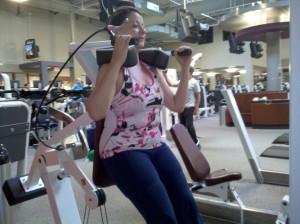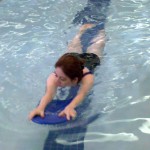The competitive racing season is off with a bang. Participating in an event might be the spark your workout needs. Many approach the idea with trepidation, only to find themselves quickly addicted to the thrill of the race. Committing to a competition can be great motivation for your exercise program. Members find this type of “deadline” inspires them to advance their routine, whether with increased duration, intensity, or both.
Warm-Up to the Idea
Member Marie Ivanov notes, “Until I began competitive racing, I could only adhere to an exercise program for about six months. Participating in half-marathons and triathlons for the past two years has really helped me remain committed to fitness. I’m determined not to place last in a competition!”

Competitive racing is quickly growing in popularity. Many runners are joining this sport in their fourth and fifth decades of life. Marie accomplished her master’s degree and various certifications prior to her recently discovered passion for multisport racing. “Your personal history doesn’t matter,” she comments. “I was never athletic before my first triathlon in my late 30s. You just need to stay focused, be determined, and enjoy it. The competitive spirit is a total adrenaline rush.”
The Center provides everything needed to prepare for a racing event, whether it’s your first or hundredth. If you’re a newbie, consider working with a personal trainer. From basic road races to marathons and triathlons, a trainer can customize a fitness plan and make suggestions based on your skill level. Additionally, having the support of an expert can ease anxiety and provide encouragement. Sharing your goals, which may include winning first place or simply finishing on your own two feet, helps obtain them. Know what you want from the experience and go for it.
There are customized training programs for racing events. You need to approach a marathon differently than you would a triathlon, and a 5K differently than a half-marathon. Be specific about what you register for and know the requirements. Here is the breakdown of several major competitions:
Recreational runs: Of various distances, often run for fun or as a means for fundraising.
5K: A running race of 5000 meters or approximately 3.1 miles. Often set to raise funds for, or awareness of, a specific cause, person, organization, or charity.
10K: A running race of 10,000 meters or 6.214 miles. Less frequent than the 5K but usually created for the same type of purpose.
5-Mile & 10-Mile Runs: A race of length implied by their names. Local community races used as recreational summer events or to help a neighborhood charity.
Half-marathon: A running race of 13.1 miles. Reported as the fastest-growing race due to its challenging but abbreviated nature.
Marathon: A long-distance running race of 26.2 miles.

Triathlon: A multisport competition that consists of swimming, bicycling, and running, in that order. Occasionally, the components are split among a team of three. Distances vary among four types of triathlons: Sprint, Olympic, Half Ironman, and Full Ironman. The Sprint triathlon is recommended for beginners. It consists of .25-mile swim, 16-mile cycle, and 3.1-mile run.
A Race to Run
It should be easy to locate competitions in your neighborhood. Often, announcements of local competitions are posted at the Center to entice members. Chat with fitness trainers, instructors, staff, and your fellow exercisers. This is a great way to find races and gain tips from veteran runners. Check wherever people gather—parks, libraries, and coffee shops. An old-fashioned posted flyer might introduce you to your next race. And, there’s always the Internet.
Some members enjoy forming a team and training together, especially when racing for a cause. The camaraderie enjoyed among those interested in a specific facet of fitness is inspiring and informative. Shared experiences can propel forward both your friendship and running skills. Personal Trainer Chris Pilla provides insight, ““I try to introduce clients that are training for endurance events so they can create their own small team within our fitness world at the Center. Members get to know each other and share this commonality. It’s another great motivating factor.”
One member commented on how her personal trainer connected her with other members who are “alumni runners,” meaning they are veterans to the competitive running experience. She claims several have become good friends. They enjoy training together, even if it’s not for the same racing events.
Trainer Chris is also president and head coach of Angels with Running Shoes (AwRS), a 100% non-profit group that provides fundraising opportunities in the form of marathons, triathlons, and such. Perhaps you have a worthy cause with no outlet. Consider AwRS as a solution for your need to race and your desire to help others. Find a cause that is close to your heart and act on it.

Many existing organizations (e.g., Susan G. Komen for the Cure® breast cancer foundation) host racing/walking events to raise funds for medical research and dissemination of factual information. Events with such a mission provide a new dimension for those participating. Suddenly, running is not just about your health, your miles covered, and your best race time. It goes beyond by helping improve the health of our community at large.
Be a Self-Starter
Once you establish your training program and connect with other runners, you may decide to organize your own racing event. Consider it a fun way to expand your passion for running. Capitalize on each group member’s skill set, with someone responsible for plotting the route and another for promoting the event. The control-freak among you can oversee all the logistics and coordination. A community event can grow rapidly, so it’s essential to remain highly organized with a solid structure to the day. You may decide to charge a minimal registration fee so you can provide awards to the top runners. Invite other Center members and staff to join your event. They may want to participate, as well as help organize it.
The Center is ideal for nurturing the runner within, whether venturing to create your own race, joining the competitive racing community, or adding yet another run to your track record. Charged with the spirit of competition, and a pre-event workout plan, you’re off to a running start!
Source
“How to Find Local Races or Marathons,” Kendra Van Wagner, www.essortment.com.
 Fitness & Wellness News Your Source for Fitness News, Wellness News, Health News, and Nutrition News!
Fitness & Wellness News Your Source for Fitness News, Wellness News, Health News, and Nutrition News!



